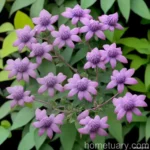Plant Profile: Indigofera tinctoria
Indigofera tinctoria, commonly known as true indigo, is a beautiful and versatile plant that has been valued for centuries for its multifaceted uses. As a plant scientist, I am excited to delve into the various aspects of this fascinating plant from its cultivation and uses to its significance in traditional medicine and folklore.

What is Indigofera tinctoria?
Indigofera tinctoria is a deciduous perennial shrub belonging to the Fabaceae family. This plant is native to the Indian subcontinent, East Asia, and parts of Africa, and has been widely cultivated for its rich blue dye. It is best known for its historical use in textile dyeing, making it a culturally and economically significant plant.
Key Takeaways
Let’s explore the multifaceted nature of Indigofera tinctoria through its culture, uses, and tips for optimal growth and care.
Culture
- Hardiness Zone: Indigofera tinctoria thrives in USDA hardiness zones 4-11.
- Growth Habit: It typically grows as a shrub, reaching a height of 3-6 feet and spreading 2-4 feet wide.
- Lifespan: With proper care, these plants can live for many years, providing a sustainable source of natural dye.
Uses
-
Dye Production: Indigofera tinctoria is renowned for its high-quality blue dye, extracted from its leaves through a complex fermentation process.
- Indigofera tinctoria dye extraction involves fermenting the leaves to release the indican compound, which subsequently undergoes a reduction process to produce the blue indigo dye.
-
Traditional Medicine: In various traditional medicinal systems, the plant has been utilized for its purported health benefits.
- Indigofera tinctoria plant uses in traditional medicine are diverse and include its use in Ayurveda for treating skin conditions, promoting hair growth, and supporting overall well-being.
Water
- Watering Needs: Indigofera tinctoria prefers moderate moisture levels, especially during its active growth phase.
- Soil Drainage: It thrives in well-draining soil to prevent waterlogging, particularly in container cultivation.
Sunlight
- Sun Requirements: This plant thrives in full sunlight, enjoying at least six hours of direct sun exposure daily.
Fertilizer
- Nutrient Needs: Indigofera tinctoria benefits from a balanced fertilizer, applied during the growing season to support healthy foliage and dye production.
Soil
- Soil Preference: Well-draining, loamy soil with a slightly acidic to neutral pH range is ideal for the optimal growth of Indigofera tinctoria.
Pruning
- Maintenance Pruning: Periodic pruning can help maintain the plant’s shape and promote healthy growth, especially after the flowering season.
Propagation
- Propagation Methods: Indigofera tinctoria can be propagated from seeds or cuttings, with each method offering unique advantages.
Container Popularity
- Container Gardening: This plant adapts well to container cultivation, enabling urban and space-limited gardeners to enjoy its beauty and utility.
Container Common Diseases
- Disease Susceptibility: Indigofera tinctoria may be vulnerable to certain fungal diseases, especially in humid or poorly ventilated conditions.
Disease Diagnosis
- Symptom Recognition: Keep a lookout for leaf spots, wilting, or mold growth, which may indicate the presence of common plant diseases.
Common Pests
- Pest Management: Indigofera tinctoria may attract aphids, caterpillars, or spider mites, necessitating proactive pest control measures.
Botanist’s Tips
- Optimal Growth Conditions: Providing well-draining soil, ample sunlight, and regular watering fosters healthy growth and a bountiful yield of dye-producing leaves.
Fun Facts
- Cultural Significance: Indigofera tinctoria has been historically revered across cultures for its dyeing capabilities and as a symbol of natural beauty and resilience.
Links to External Resources
For further exploration of Indigofera tinctoria and its diverse facets, the following resources provide valuable insights:
– Royal Botanic Gardens, Kew – Indigofera tinctoria
– USDA Plants Database – Indigofera tinctoria
– International Journal of Pharmaceutical Sciences and Research – Medicinal Properties of Indigofera tinctoria
In conclusion, Indigofera tinctoria stands as a remarkable plant with a rich history of cultural, medicinal, and industrial significance. By understanding its cultivation, uses, and ecological importance, we can truly appreciate the profound impact of this botanical treasure. Whether as a source of natural dye, a traditional medicine, or a cherished ornamental, Indigofera tinctoria continues to captivate plant enthusiasts and researchers alike with its enduring allure and practical value.















